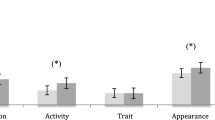Abstract
Two hundred twenty-eight respondents (110 heterosexuals and 118 homosexuals) completed a survey containing a 20-item Boyhood Gender Conformity Scale (BGCS). This scale was largely composed of edited and abridged gender items from Part A of Freund et al.'s Feminine Gender Identity Scale (FGISA) and Whitam's “childhood indicators.” The combined scale was developed in an attempt to obtain a reliable, valid, and potent discriminating instrument for accurately classifying adult male respondents for sexual orientation on the basis of their reported boyhood gender conformity or nonconforming behavior and identity. In addition, 33% of these respondents were administered the original FGIS-A and Whitam inventory during a 2-week test-retest analysis conducted to determine the validity and reliability of the new instrument. All the original items significantly discriminated between heterosexual and homosexual respondents. From these a 13-item function and a 5-item function proved to be the most powerful discriminators between the two groups. Significant correlations between each of the three scales and a very high test-retest correlation coefficient supported the reliability and validity assumption for the BGCS. The conclusion was made that the five-item function (playing with boys, prefering boys' games, imagining self as sports figure, reading adventure and sports stories, considered a “sissy”) was the most potent and parsimonious discriminator among adult males for sexual orientation. It was similarly noted that the absence of masculine behaviors and traits appeared to be a more powerful predictor of later homosexual orientation than the traditionally feminine or cross-sexed traits and behaviors.
Similar content being viewed by others
References
Bell, A. P., Weinberg, M. S. and Hammersmith, S. K. (1981).Sexual Preference Indiana University Press, Bloomington.
Bieber, I., Dain, H. J., Dince, P. R., Drellich, M. G., Grand, H. G., Gondlach, R. H. Kremer, M. W., Rifkin, A. H., Wilber, C. B., and Bieber, T. B. (1962).Homosexuality: A Psychoanalytic Study Basic Books, New York.
Billingham, R. E., and Hockenberry, S. L. (1987). Gender conformity, masturbation fantasy, infatuation, and sexual orientation: A discriminant analysis investigation.J. Sex. Res. 23: 368–374.
Blanchard, R., McConkey, J. G., Roper, V., and Steiner, B. W. (1983). Measuring physical aggressiveness in heterosexual, homosexual, and transsexual males.Arch. Sex. Behav. 12: 511–524.
Freund, K., and Blanchard, R. (1983). Is the distant relationship of fathers and homosexual sons related to the sons' erotic preference for male partners, or to the sons' atypical gender identity, or both?J. Homosex. 9: 7–25.
Freund, K., Nagler, E., Langevin, R., Zajac, A., and Steiner, B. (1974). Measuring feminine gender identity in homosexual males.Arch. Sex. Behav. 3: 249–260.
Freund, K., Langevin, R., Satterberg, J., and Steiner, B. (1977). Extension of the gender identity scale for males.Arch. Sex. Behav. 6: 507–519.
Green, R. (1974).Sexual Identity Conflict in Children and Adults Basic Books, New York.
Green, R. (1976). One-hundred ten feminine and masculine boys: Behavioral contrasts and demographic similarities.Arch. Sex. Behav. 5: 425–446.
Green, R. (1979). Childhood cross-gender behavior and subsequent sexual preference.Am. J. Psychiat. 136: 106–108.
Green, R. (1985). The gender identity disorder of childhood and later sexual orientation: Follow-up of 78 males.Am. J. Psychiat. 142: 339–341.
Green, R. (1987).The “Sissy Boy Syndrome” and the Development of Homosexuality Yale University Press, New Haven.
Hair, Jr., J. F., Anderson, R. E., Talham, R. L., and Grablowsky, B. J. (1984).Multivariate Data Analysis Macmillan, New York.
Harry, J. (1982).Gay Children Grown-Up: Gender Culture and Gender Deviance Praeger, New York.
Hockenberry, S. L. (1985). Male sexual orientation: The development roles of gender identity, affectional, and erotic cognitions. Unpublished thesis, Indiana University.
Kinsey, A. C., Pomeroy, W. B., and Martin, C. E. (1948).Sexual Behavior in the Human Male W. B. Saunders, Philadelphia.
Ross, M. W. (1980). Retrospective distortion in homosexual research.Arch. Sex. Behav. 9: 523–531.
Saghir, M., and Robins, E. (1973).Male and Female Homosexuality Williams & Wilkins, Baltimore.
Spanier, G. B. (1976). Use of recall data in survey research on human sexual behavior.Soc. Biol. 23: 244–253.
Thompson, N. L., Setiwartz, D. M., McCandless, B. R., and Edwards, D. A. (1973). Parentchild relationships and sexual identity in male and female homosexuals and heterosexuals.J. Consult. Clin. Psychol. 41: 120–127.
Whitam, F. L. (1977). Childhood indicators of male homosexuality.Arch. Sex. Behav. 6: 89–96.
Whitam, F. L. (1980). The prehomosexual male child in three societies: The United States, Guatemala, Brazil,Arch. Sex. Behav. 9: 87–99.
Whitam, F. L., and Mathy, R. M. (1986).Male Homosexuality in Four Societies: Brazil, Guatemala, The Philippines, and the United States. Praeger, New York.
Whitam, F. L., and Zent, M. (1984). A cross-cultural assessment of early cross-gender behavior and familial factors in male homosexuality.Arch. Sex. Behav. 13: 427–439.
Author information
Authors and Affiliations
Rights and permissions
About this article
Cite this article
Hockenberry, S.L., Billingham, R.E. Sexual orientation and boyhood gender conformity: Development of the Boyhood Gender Conformity Scale (BGCS). Arch Sex Behav 16, 475–492 (1987). https://doi.org/10.1007/BF01541712
Issue Date:
DOI: https://doi.org/10.1007/BF01541712




